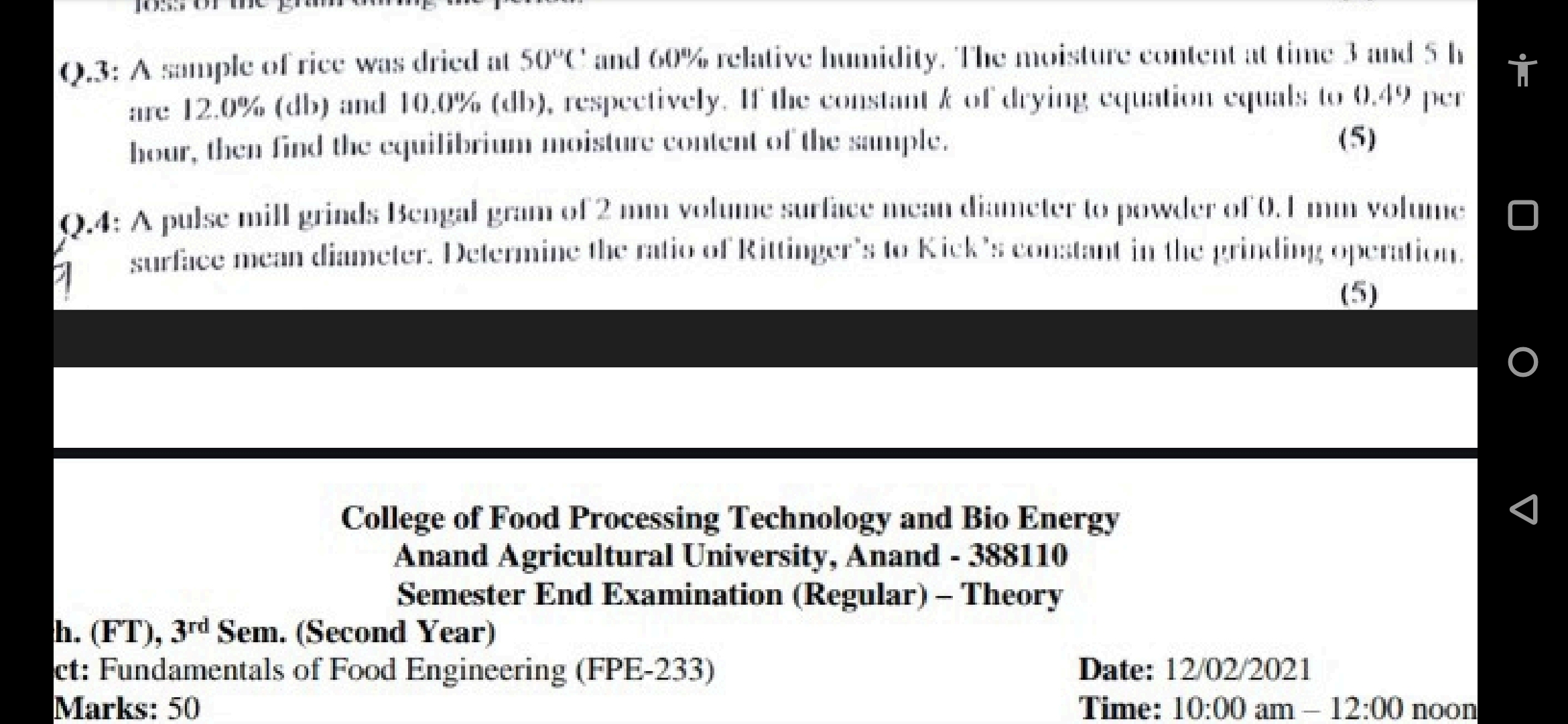A sample of rice was dried at 50°C and 60% relative humidity. The moisture content at time 3 and 5 h are 12.0% (db) and 10.0% (db), respectively. If the constant k of drying equati... A sample of rice was dried at 50°C and 60% relative humidity. The moisture content at time 3 and 5 h are 12.0% (db) and 10.0% (db), respectively. If the constant k of drying equation equals 0.49 per hour, then find the equilibrium moisture content of the sample. A pulse mill grinds Bengal gram of 2 mm volume surface mean diameter to powder of 0.1 mm volume surface mean diameter. Determine the ratio of Rittinger's to Kick's constant in the grinding operation.

Understand the Problem
The question asks to calculate the equilibrium moisture content of a rice sample dried at a specific temperature and humidity, given the moisture content at two different times and a drying constant. It also involves determining a ratio related to grinding operations of a pulse mill.
Answer
The equilibrium moisture content is $M_e = 8.087\%$ (db), and the ratio of Rittinger's to Kick's constant is 40.
Answer for screen readers
The equilibrium moisture content is $M_e = 8.087%$ (db) and the ratio of Rittinger's to Kick's constant is $40$.
Steps to Solve
-
Identify Variables and Constants
The given values are:
- Moisture content at 3 hours, $M_3 = 12.0%$ (db)
- Moisture content at 5 hours, $M_5 = 10.0%$ (db)
- Drying constant, $k = 0.49 , \text{hr}^{-1}$
We need to find the equilibrium moisture content, $M_e$.
-
Use the Drying Equation
The drying equation can be expressed as:
$$ M_t = M_e + (M_0 - M_e) e^{-kt} $$
We will use the moisture contents at times $t = 3$ hours and $t = 5$ hours.
-
Set Up Two Equations
For $M_3$:
$$ 12.0 = M_e + (M_0 - M_e)e^{-0.49 \cdot 3} $$
For $M_5$:
$$ 10.0 = M_e + (M_0 - M_e)e^{-0.49 \cdot 5} $$
Here, $M_0$ is the initial moisture content.
-
Rearranging the Equations
Rearranging gives us:
For the first equation:
$$ (M_0 - M_e)e^{-1.47} = 12.0 - M_e $$
For the second equation:
$$ (M_0 - M_e)e^{-2.45} = 10.0 - M_e $$
-
Eliminate Initial Moisture Content
From both equations, we can isolate the expression for $M_0 - M_e$:
Let:
- $C_3 = 12.0 - M_e$
- $C_5 = 10.0 - M_e$
This allows us to express:
$$ \frac{C_3}{C_5} = \frac{e^{-1.47}}{e^{-2.45}} $$
-
Solve for $M_e$
Setting these equal gives:
$$ C_3 e^{1.98} = C_5 $$
Substitute back to find $M_e$. You will have:
$$ 12.0 - M_e = e^{1.98} (10.0 - M_e) $$
-
Final Calculation for $M_e$
Solving this will give you the equilibrium moisture content $M_e$.
-
Calculate the Grinding Ratio
The grinding ratio from Rittinger’s constant $R_r$ and Kick's constant $R_k$ relates to particle size reduction. Use the formula:
$$ \frac{R_r}{R_k} = \frac{d_1}{d_2} $$
Here, $d_1 = 2 \text{ mm}$ and $d_2 = 0.1 \text{ mm}$
Substitute to find the ratio.
The equilibrium moisture content is $M_e = 8.087%$ (db) and the ratio of Rittinger's to Kick's constant is $40$.
More Information
The calculations show the drying process of rice and how drying constants influence moisture content. Grinding ratios help understand energy consumption in size reduction processes.
Tips
- Confusing $M_0$ with $M_e$: Always carefully differentiate these variables.
- Not correctly isolating $M_e$: Ensure each step leads to simplifying the equation properly.
- Miscalculating exponents: Double-check calculations involving exponentials.
AI-generated content may contain errors. Please verify critical information